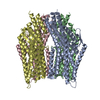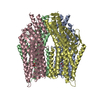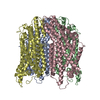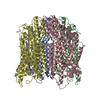[English] 日本語
 Yorodumi
Yorodumi- PDB-8jmi: The cryo-EM structure of insect gustatory receptor Gr64a from Dro... -
+ Open data
Open data
- Basic information
Basic information
| Entry | Database: PDB / ID: 8jmi | ||||||
|---|---|---|---|---|---|---|---|
| Title | The cryo-EM structure of insect gustatory receptor Gr64a from Drosophila melanogaster in complex with maltose | ||||||
 Components Components | Gustatory receptor for sugar taste 64a | ||||||
 Keywords Keywords |  MEMBRANE PROTEIN / gustatory receptor / Gr64a / MEMBRANE PROTEIN / gustatory receptor / Gr64a /  maltose / maltose /  ligand-gated ion channel ligand-gated ion channel | ||||||
| Function / homology |  Function and homology information Function and homology information proboscis extension reflex / sweet taste receptor activity / detection of chemical stimulus involved in sensory perception of taste / proboscis extension reflex / sweet taste receptor activity / detection of chemical stimulus involved in sensory perception of taste /  taste receptor activity / sensory perception of sweet taste / sensory perception of taste / taste receptor activity / sensory perception of sweet taste / sensory perception of taste /  signal transduction / signal transduction /  membrane / membrane /  plasma membrane plasma membraneSimilarity search - Function | ||||||
| Biological species |   Drosophila melanogaster (fruit fly) Drosophila melanogaster (fruit fly) | ||||||
| Method |  ELECTRON MICROSCOPY / ELECTRON MICROSCOPY /  single particle reconstruction / single particle reconstruction /  cryo EM / Resolution: 2.6 Å cryo EM / Resolution: 2.6 Å | ||||||
 Authors Authors | Ma, D. / Guo, J. | ||||||
| Funding support |  China, 1items China, 1items
| ||||||
 Citation Citation |  Journal: Science / Year: 2024 Journal: Science / Year: 2024Title: Structural basis for sugar perception by gustatory receptors. Authors: Demin Ma / Meiqin Hu / Xiaotong Yang / Qiang Liu / Fan Ye / Weijie Cai / Yong Wang / Ximing Xu / Shenghai Chang / Ruiying Wang / Wei Yang / Sheng Ye / Nannan Su / Minrui Fan / Haoxing Xu / Jiangtao Guo /   Abstract: Insects rely on a family of seven transmembrane proteins called gustatory receptors (GRs) to encode different taste modalities, such as sweet and bitter. We report structures of sweet taste ...Insects rely on a family of seven transmembrane proteins called gustatory receptors (GRs) to encode different taste modalities, such as sweet and bitter. We report structures of sweet taste receptors GR43a and GR64a in the apo and sugar-bound states. Both GRs form tetrameric sugar-gated cation channels composed of one central pore domain (PD) and four peripheral ligand-binding domains (LBDs). Whereas GR43a is specifically activated by the monosaccharide fructose that binds to a narrow pocket in LBDs, disaccharides sucrose and maltose selectively activate GR64a by binding to a larger and flatter pocket in LBDs. Sugar binding to LBDs induces local conformational changes, which are subsequently transferred to the PD to cause channel opening. Our studies reveal a structural basis for sugar recognition and activation of GRs. | ||||||
| History |
|
- Structure visualization
Structure visualization
| Structure viewer | Molecule:  Molmil Molmil Jmol/JSmol Jmol/JSmol |
|---|
- Downloads & links
Downloads & links
- Download
Download
| PDBx/mmCIF format |  8jmi.cif.gz 8jmi.cif.gz | 631.8 KB | Display |  PDBx/mmCIF format PDBx/mmCIF format |
|---|---|---|---|---|
| PDB format |  pdb8jmi.ent.gz pdb8jmi.ent.gz | 532.9 KB | Display |  PDB format PDB format |
| PDBx/mmJSON format |  8jmi.json.gz 8jmi.json.gz | Tree view |  PDBx/mmJSON format PDBx/mmJSON format | |
| Others |  Other downloads Other downloads |
-Validation report
| Arichive directory |  https://data.pdbj.org/pub/pdb/validation_reports/jm/8jmi https://data.pdbj.org/pub/pdb/validation_reports/jm/8jmi ftp://data.pdbj.org/pub/pdb/validation_reports/jm/8jmi ftp://data.pdbj.org/pub/pdb/validation_reports/jm/8jmi | HTTPS FTP |
|---|
-Related structure data
| Related structure data |  36422MC  8jm9C  8jmaC  8jmeC  8jmhC  8x82C  8x83C  8x84C M: map data used to model this data C: citing same article ( |
|---|---|
| Similar structure data | Similarity search - Function & homology  F&H Search F&H Search |
- Links
Links
- Assembly
Assembly
| Deposited unit | 
|
|---|---|
| 1 |
|
- Components
Components
| #1: Protein | Mass: 54668.250 Da / Num. of mol.: 4 Source method: isolated from a genetically manipulated source Source: (gene. exp.)   Drosophila melanogaster (fruit fly) / Gene: Gr64a, CG32261 / Production host: Drosophila melanogaster (fruit fly) / Gene: Gr64a, CG32261 / Production host:   Homo sapiens (human) / References: UniProt: P83293 Homo sapiens (human) / References: UniProt: P83293#2: Polysaccharide | alpha-D-glucopyranose-(1-4)-beta-D-glucopyranose Has ligand of interest | Y | |
|---|
-Experimental details
-Experiment
| Experiment | Method:  ELECTRON MICROSCOPY ELECTRON MICROSCOPY |
|---|---|
| EM experiment | Aggregation state: PARTICLE / 3D reconstruction method:  single particle reconstruction single particle reconstruction |
- Sample preparation
Sample preparation
| Component | Name: gustatory receptor Gr64a / Type: ORGANELLE OR CELLULAR COMPONENT / Entity ID: #1 / Source: MULTIPLE SOURCES |
|---|---|
| Source (natural) | Organism:   Drosophila melanogaster (fruit fly) Drosophila melanogaster (fruit fly) |
| Source (recombinant) | Organism:   Homo sapiens (human) Homo sapiens (human) |
| Buffer solution | pH: 7.4 |
| Specimen | Embedding applied: NO / Shadowing applied: NO / Staining applied : NO / Vitrification applied : NO / Vitrification applied : YES : YES |
Vitrification | Cryogen name: ETHANE |
- Electron microscopy imaging
Electron microscopy imaging
| Experimental equipment |  Model: Titan Krios / Image courtesy: FEI Company |
|---|---|
| Microscopy | Model: FEI TITAN KRIOS |
| Electron gun | Electron source : :  FIELD EMISSION GUN / Accelerating voltage: 300 kV / Illumination mode: FLOOD BEAM FIELD EMISSION GUN / Accelerating voltage: 300 kV / Illumination mode: FLOOD BEAM |
| Electron lens | Mode: BRIGHT FIELD Bright-field microscopy / Nominal defocus max: 1500 nm / Nominal defocus min: 800 nm Bright-field microscopy / Nominal defocus max: 1500 nm / Nominal defocus min: 800 nm |
| Image recording | Electron dose: 52 e/Å2 / Film or detector model: FEI FALCON IV (4k x 4k) |
- Processing
Processing
CTF correction | Type: PHASE FLIPPING AND AMPLITUDE CORRECTION |
|---|---|
3D reconstruction | Resolution: 2.6 Å / Resolution method: FSC 0.143 CUT-OFF / Num. of particles: 529197 / Symmetry type: POINT |
 Movie
Movie Controller
Controller









 PDBj
PDBj

